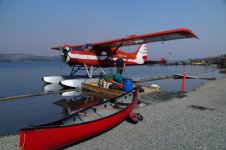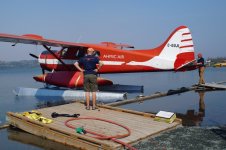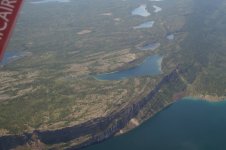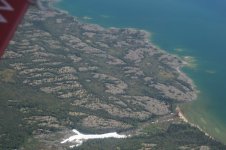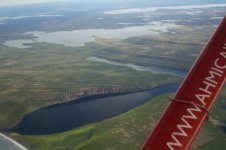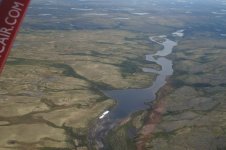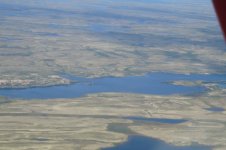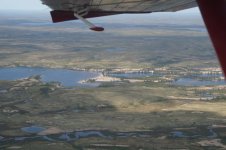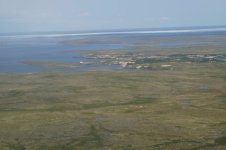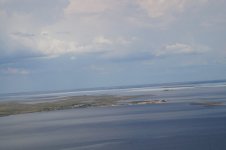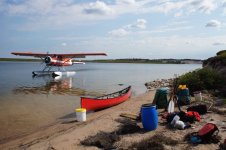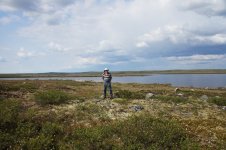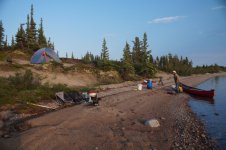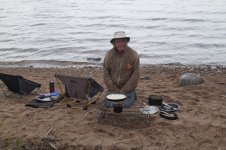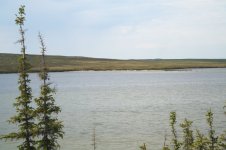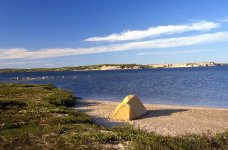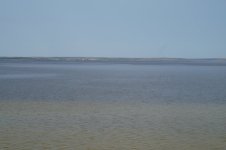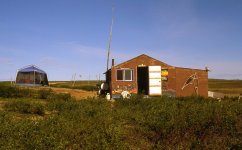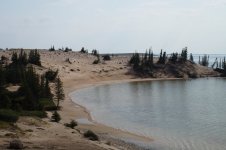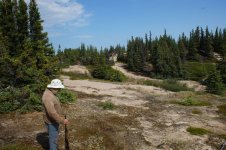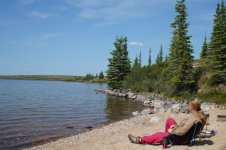Monday, July 4. Our 41st Anniversary. We exchanged the following cards.
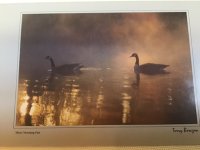
Dearest Kathleen of Mine,
Like geese, who also mate forever, we are so fortunate to paddle and float together, once more, in the Barren Grounds of Canada.
Happy Anniversary!
Love, Michael
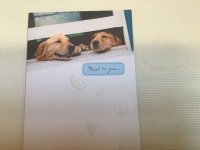
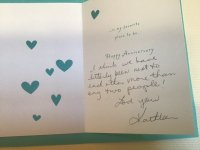
There was no restaurant or cafe serving breakfast within walking distance from the Aurora Bayside Inn, so we purchased English muffins last night from a nearby general store. We toasted them in the common kitchen area of the Aurora Bayside Inn, topped with margarine and jam that we pirated from our canoe trip supplies.
We then wandered over to the Ahmic Air float plane dock, where we met Robert Perkins, producer of the video of
Into The Great Solitude: An Arctic Journey—a truly epic 73-day solo canoe trip down the Back River, as he retraced the journey of British Navy Captain George Back, who explored the Canadian tundra by canoe in 1834. Perkins’s presentation was superbly inspirational, and I wanted to get a picture of the two of us together.
“Mr. Perkins. Do you mind if we take your picture?”
“Yes I do.”
Two points of clarification. It has been several decades since I have used the honorific “Mr.,” which is “a title that conveys esteem, courtesy, or respect for position or rank when used in addressing or referring to a person.” Yep. That’s how I felt about Robert Perkins. Second, Mr. Perkins had just slipped and partially fallen into the water. He didn’t think the picture would be flattering. But Mr. Perkins relented, and Kathleen took two pictures of us standing next to each other. Mr. Perkins was correct. The image was unflattering. Not just for him, but also for me. My pants were a bit tight, and a smidge bulgy in the crotch area. I was excited to be with Mr. Perkins, but not that excited. I have provided a cropped image to prove that I had indeed met Mr. Robert Perkins.

Mr. Robert Perkins And Me
“You know,” I said to Mr. Perkins, “my favourite part of your video was when you realized that you were actually standing on the island that you were looking for.”
“Yeah, I’m glad we left that part in.”
After a hurried handshake, Mr. Perkins climbed up into the DHC-2 Beaver, and flew away for a five-week solo trip beginning on the Baillie River, a tributary of the Back River. The Arctic Fever still possesses the man.
Our friends from the Northwest Territories Visitor Information Centre were busy organizing their gear for departure. Stephen referred to them as Les’s group. We never heard the daughter’s name. She had often paddled with her father, who would be canoeing solo down the Coppermine River. His daughter would be paddling with her uncle Ed, in a packboat. She had never paddled with uncle Ed, and she had never paddled in a packboat. She asked Stephen if a packboat was appropriate for the Coppermine River. “It’s more like a raft,” he said. I don’t know if Stephen meant that as a positive or a negative compared to a hardshell canoe.
Uncle Ed arrived only this morning, and had a mountain of gear not anticipated by Les, his daughter, or Stephen. In fact, the combined piles of gear did not fit into a single float plane, and the group were obliged to hire a second flight. Uncle Ed was not happy, and mumbled just loud enough for bystanders to hear. ”You’d think that an established float plane company would know what they’re doing.”
"Well, Ed, you can see that the pontoons are already pretty deep in the water. We can’t fit anymore gear. You need to book a second flight if you want to take all this stuff.”
“Are you sure that you pumped out the pontoons from previous flights?” Ed asked this somewhat sarcastically, and with the decided tone of a know-it-all. This expedition was not off to a good start, and the daughter looked worried. “You seem worried,” she said,” to me. “And that’s making me worried.”
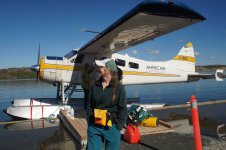
Thinking About Paddling With Uncle Ed
“Sorry. I’m sure everything will be fine.” I was a bit concerned, though. Ed would be paddling stern, and she would be paddling bow. The Coppermine is a challenging river. Ed struck me as the kind of guy who would immediately blame his niece for all canoeing mishaps, however minor they might be, or who deserved the blame. It reminded me of Chris and Walter, members of our canoe club in Vancouver. Walter was a good-looking guy, as he readily acknowledged. He once told me that when he got up in the morning, and looked in the mirror, he would say to himself, “dang, I am
so good looking.” Well, on one of our day trips with the canoe club, Walter had been badgering Chris ever since the put-in. Chris suddenly turned around to face Walter in the stern. “You think you’re so dang good, you paddle the canoe.” Then, with a flourish, she leaped out of the canoe and swam away.
The float plane crew was now hurriedly loading the first plane. Stephen’s father and I enjoyed watching, while chatting about all things float planes and canoe trips. Passengers climbed aboard the first plane, and it floated away easily from the dock. Work then began loading the second plane. I fretted a little about their group dynamic. But Les and Ed had both paddled the Coppermine several times before. Things should work out. Anyway, it was not my problem.
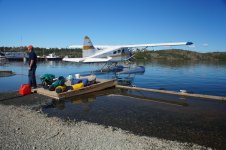
First Float Plane Leaves the Dock. Still Lots of Gear Left.

Taxiing For Takeoff
After lunch Kathleen and I reorganized our gear for the canoe trip. I had difficulty lifting the heaviest pack and taking it out to the car. The pack has never seemed so heavy. I hope this trip doesn’t become too arduous.
For our anniversary supper we dined at Yellowknife’s iconic Bullocks Bistro, where we met a friendly couple from Edmonton. The guy worked in Yellowknife 50 years ago, and had returned to celebrate his birthday—an excellent place to remember days gone by.
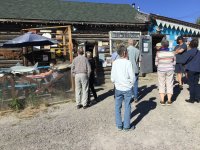
For Supper, We Joined the Crowds at Bullocks Bistro.
A Must Dining Experience in Old Town Yellowknife
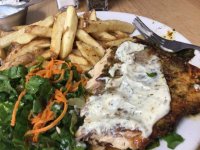
Kathleen Dined on Pan-fried Lake Trout.
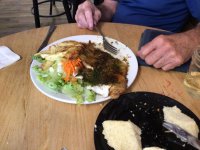
I Feasted on Whitefish—Freshly Caught in Great Slave Lake.
After supper we sat on the deck of the Aurora Bayside Inn, with a glass of white wine, enjoying the calm, warm evening. We were soon joined by two Austrians, whose Air Canada flight had been delayed, and they were now one day behind their scheduled flight into the Snowdrift River. Even worse, their luggage had not yet arrived. Despite the obvious disappointment, they remained upbeat. They had both done the Thelon River before, as had we. They had both paddled the Snowdrift River before, as had we. They preferred the boreal forest that surrounded the Snowdrift River, compared to the tundra surrounding the Thelon River. One of the men proudly displayed the drone with which he intended to film their canoeing expedition. They probably won’t be leaving, though, for another two days. “I hope there’s no one else there,” he said.
After waiting for two years, Kathleen and I fly out to the Barren Grounds tomorrow. “It is a land uncircumscribed, for it has no limits that the eye can find. It seems to reach beyond the finite boundaries of this earth. Brooding, immutable, it showed so harsh a face to the first white men who came upon its verges that they named it, in awe and fear, the Barren Grounds.” So wrote Farley Mowat, in his book
Tundra.
Learn about tundra.
"Tundra is a Russian term meaning a rolling treeless plain. Colloquially it often is called the barren lands. It is treeless, but not barren. It is a special landscape with a marvellous seasonal array of natural processes flawlessly executed by a carefully selected diversity of ecosystems.
Nevertheless, the environment is severe, which allows only a few selected species to succeed on the tundra. Of the 3200 species of mammals, only a maximum of 23 succeed beyond the tree line on the North American tundra. Of 8600 species of birds, only 6 or 7 live year-round on the tundra, although another 70 species come for the breeding seasons. Of the vast diversity of insects, only about 600 species succeed on the tundra. Some succeed beyond our fondest hopes!”
Obviously the native peoples of the tundra didn’t refer to their homeland as the Barren Grounds. The Inuit referred to their homeland simply as Inuit Nunangat, which refers to the land, water and ice contained in the Arctic Region. No matter what one calls the landscape, tomorrow Kathleen and I will fly 373 km (232 miles) to the northwest corner of Whitefish Lake, surrounded by our favourite landscape, the Barren Grounds.











